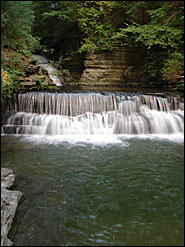Home > BasicsWaterfalls & Gorges in the Finger Lakes
There are nearly 900 waterfalls in the Finger Lakes, according to Scott Ensminger, waterfall afficionado and author of Finger Lakes Falls, all just as lovely as Chequaga Falls. Waterfalls were created as shelves of Photographing WaterfallsAnyone can photograph a waterfall. But taking a great photo can be a real challenge. Because waterfalls tend to be long (vertical), you often need to stand way back to get the entire fall in frame. Trees and other plants growing in the area of the falls can often get in the way of your view. Falls are often in gorges and, while the sun may be shining, the light in the gorge may be dim creating contrast problems. In addition, sunlight can reflect (bounce) off
1. If you want to take a straight-on shot, make sure your view is well lighted and unobstructed.
2. Stand far enough back to get the entire fall. You may need to stand in the water or on the top of the gorge overlook the fall rather than taking your photo from the trail. (Try to think outside the box.)
3. Watch how the sun is shining. If it's shining onto the water as it falls, consider positioning yourself slightly to the side of the fall to avoid light bouncing off the water. Using a Polarizing lens can also help eliminate glare.
4. If the gorge is dark, you will need to use a longer exposure time. Remember that a fast shutter speed catches the water in the act of falling, sometimes in mid-air. A slow shutter speed, slower than the speed of the water, creates that dreamy, milky look.
5. Putting something in your picture next to the fall, a person for example, can provide a reference so that viewers can tell how large or small the waterfall is. Where to Find WaterfallsMost of the waterfalls in the Finger Lakes are on private land. But many are on land open to the public. Some waterfalls can even be viewed from the nearest road. (These waterfalls make excellent viewing for the disabled.) Directions to these waterfalls are available in a number of publications, from Ruth's Waterfalls, nyfalls.com, and Western New York Waterfall Survery. Entering Private LandRemember that, unlike in much of Europe where large estates are open to hiking, in New York State private l Rules of Good Behavior• Try to stay on established trails. • Don't pick the wildflowers or leave trash. • Keep dogs leashed at all times. ReferencesFinger Lakes Falls by Scott A. Ensminger, 2001. Falzguy Publishing, North Tonawanda, NY. (Unfortuantely this book is already out of print, and the author says he has no plans to reprint it. Look for it in used book shops or request it through interlibrary loan.)
Waterfalls of the Great Lakes Region, an interesting Web site with photos of some of the more popular and accessible waterfalls in the Finger Lakes.
*Also known as Chequagah Falls, Shequaga Falls, and She-Qua-Ga Falls.
Updated 18 August 2009
|
|
|


 Rumor has it that, while on tour in the Finger Lakes some time around 1820, Louis-Philippe, who would later become king of France (1830-1848), made a sketch of the lovely Chequaga Falls* (right) in the Town of Montour Falls. This sketch is said to be part of the collection at the Louvre.
Rumor has it that, while on tour in the Finger Lakes some time around 1820, Louis-Philippe, who would later become king of France (1830-1848), made a sketch of the lovely Chequaga Falls* (right) in the Town of Montour Falls. This sketch is said to be part of the collection at the Louvre.  rock (former layers of sediment) in the gorges break off due to wear and tear by the water or by the freezing and thawing action of the water during the winter that cracks the rocks along natural fissures, often leaving piles of broken rock at the base of the falls. The "hanging valleys" continue to erode upstream over time until the waterfall ceases to exit. Taughannock Falls (left), the highest falls in the northeastern United States, is the only true hanging valley left in the Finger Lakes.
rock (former layers of sediment) in the gorges break off due to wear and tear by the water or by the freezing and thawing action of the water during the winter that cracks the rocks along natural fissures, often leaving piles of broken rock at the base of the falls. The "hanging valleys" continue to erode upstream over time until the waterfall ceases to exit. Taughannock Falls (left), the highest falls in the northeastern United States, is the only true hanging valley left in the Finger Lakes. the water as it falls, creating circular light spots on the picture. Here are some things to consider when photographing waterfalls.
the water as it falls, creating circular light spots on the picture. Here are some things to consider when photographing waterfalls. and is closed to visitors unless permission is specifically given. If you enter a property that is posted as closed to visitors or not posted at all, you are considered a trespasser and can be fined $250 for trespassing. If you have questions about whether the property is open to visitors or if you would like to ask permission to enter the property, contact the property owner.
and is closed to visitors unless permission is specifically given. If you enter a property that is posted as closed to visitors or not posted at all, you are considered a trespasser and can be fined $250 for trespassing. If you have questions about whether the property is open to visitors or if you would like to ask permission to enter the property, contact the property owner.